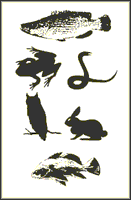Nebraska Cooperative Fish and Wildlife Research Unit

Nebraska Cooperative Fish and Wildlife Research Unit: Staff Publications
Date of this Version
2011
Citation
Bajer, P. G., C. J. Chizinski, and P. W. Sorensen. 2011. Use of radio-tagged ‘Judas’ fish to track and remove winter aggregations of common carp in Midwestern lakes. Fisheries Management and Ecology, 18:497-505.
Abstract
Radio- and acoustic telemetry in three Midwestern lakes demonstrated that common carp, Cyprinus carpio L., aggregate as water temperatures descend below 10C. Particularly dense aggregations formed at temperatures <5 >C, and once located, these aggregations could be removed with an efficiency of up to 94% using seine nets. Carp aggregated just below the surface of the ice (approximately 1.5 m) and rarely descended to warmer waters, which extended down to 10 m. Although aggregations consistently formed close to shore, their locations could not be explained by temperature or dissolved oxygen. The aggregations also moved frequently, making radio-tagged fish invaluable to locate them. Coldwater aggregations of carp may reflect a type of shoaling behaviour and can be exploited with the aid of radio-tagged (Judas) fish to control this invasive fish effectively. Similar approaches might be developed for other gregarious invasive fishes.
Included in
Aquaculture and Fisheries Commons, Environmental Indicators and Impact Assessment Commons, Environmental Monitoring Commons, Natural Resource Economics Commons, Natural Resources and Conservation Commons, Water Resource Management Commons


Comments
US government work.